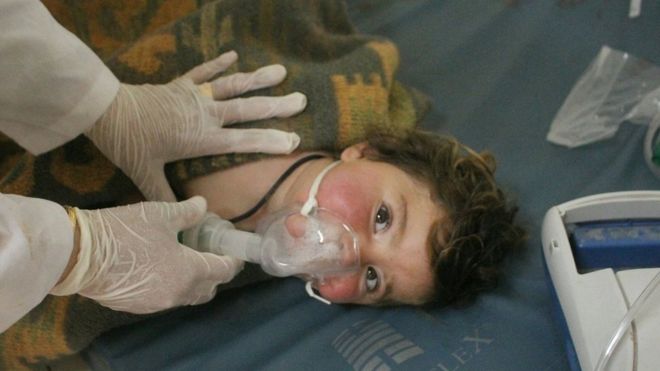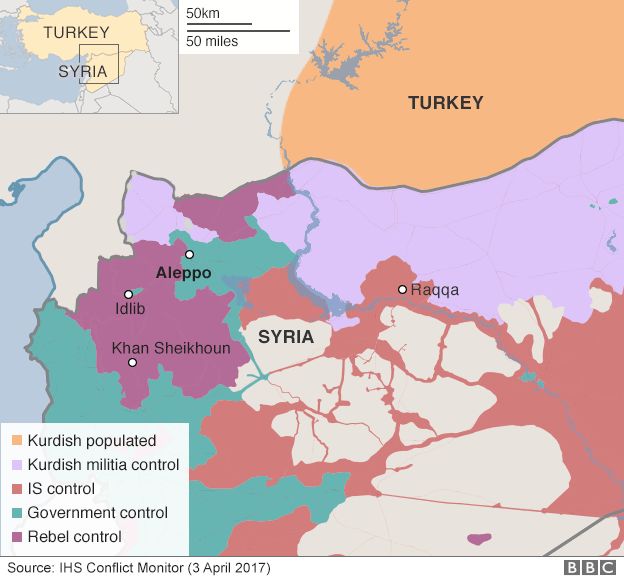 EPA
EPA
France says it has evidence showing the Syrian air force "undoubtedly" dropped bombs containing the nerve agent Sarin on a rebel-held town last month.
Foreign Minister Jean-Marc Ayrault told reporters that samples taken from the scene bore the "signature" of Sarin produced by Syria's government.
At least 87 people were killed in the incident in Khan Sheikhoun, according to an opposition-run health authority.
Syrian President Bashar al-Assad has dismissed it as a "fabrication".
He insists the government has never used chemical weapons and that it turned over all of its stocks in 2013, after it was blamed by Western powers for a Sarin attack on rebel-held suburbs of Damascus that left hundreds dead.
- Syria 'chemical attack': What we know
- Why was Shayrat airbase bombed?
- What can forensics tell us?
- Why is there a war in Syria?
Hundreds of people suffered symptoms consistent with reaction to a nerve agent after what the opposition and the US say was a Syrian Air Force attack on Khan Sheikhoun on 4 April.
 REUTERS
REUTERS
Last week, the Organisation for the Prohibition of Chemical Weapons (OPCW) said analysis of bio-medical samples collected from three victims had presented "incontrovertible" proof that they were exposed to Sarin or a Sarin-like substance.
Wednesday's declassified French intelligence report concludes that the Sarin was manufactured by the Syrian government.
"We know, from a certain source, that the process of fabrication of the samples taken is typical of the method developed in Syrian laboratories," said Mr Ayrault.

"This method is the signature of the regime and it is what enables us to establish the responsibility of the attack. We know because we kept samples from previous attacks that we were able to use for comparison," he added.
The report says France - which backs the opposition to Mr Assad - obtained environmental samples collected at one of the impact points of the suspected attack, and that its analysis revealed the presence of Sarin, the secondary product diisopropyl methylphosphonate (DIMP) and hexamine.
"The process of synthesizing Sarin, developed by the [Syrian government's] Scientific Studies and Research Centre (SSRC) and employed by the Syrian armed forces and security services, involves the use of hexamine as a stabilizer. DIMP is also known as a by-product generated by this process," it adds.

The document concludes that the Sarin from Khan Sheikhoun was produced using the same manufacturing process as that found in an unexploded grenade allegedly dropped by a government helicopter on rebel-held Saraqeb on 29 April 2013.
It also says that rebel and jihadist groups operating in the area around Khan Sheikhoun did not have the capability to employ a neurotoxic agent or access to aircraft. The theory of an attack perpetrated by so-called Islamic State is also not credible because the group is not present in the region, it adds.
"Neither do the French services assess that the theory of a staged attack or manipulation by the opposition is credible, particularly because of the massive influx in a very limited time towards hospitals in Syria and Turkey, and the simultaneous, massive uploading of videos showing symptoms of the use of neurotoxic agents."
The US has carried out a cruise missile strike on a airbase where it said the aircraft that bombed Khan Sheikhoun took off and blacklisted 271 SSRC employees.
- Syria 'chemical attack': What we know
- Syria 'chemical attack': What can forensics tell us?
- Syria 'chemical attack': What now?
- Why is there a war in Syria?
- The spectre of nerve agents in Syria - again
- Assad is secure, but Syria's war shows no sign of ending
- Six decisive points that changed Syria's war
- Returning home to ruins of East Aleppo
- Aleppo: Before and after images
- Syria peace talks: Armed groups come in from the cold
- Turkish policy sets new path for Syria
- Obama's Syria legacy
- After Aleppo, what next for Syria?
- Islamic State and the crisis in Iraq and Syria in maps
- What's left of Syria after five years of war?
- Syria's war: Special report

No comments:
Post a Comment